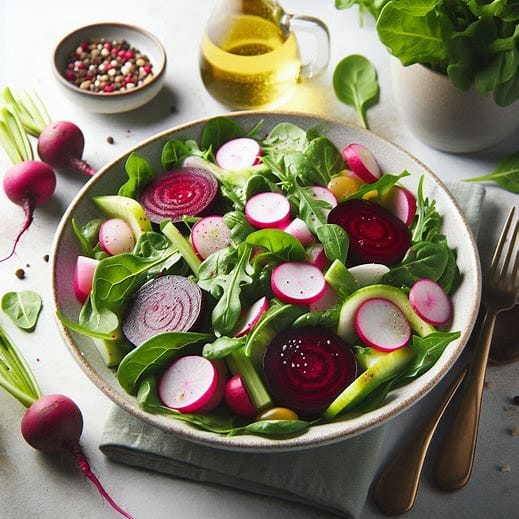Nitric oxide (NO) is a robust molecule in your physique that helps your blood vessels loosen up, enhancing blood circulate and coronary heart well being. The most effective half? You may enhance your nitric oxide ranges simply by consuming the suitable veggies! Some greens are full of nitrates, which your physique turns into nitric oxide, supplying you with advantages like decrease blood strain and even higher train efficiency. You want about 300 mg of nitrates a day to get the complete advantages seen in analysis research. On this article, we’ll have a look at the highest 10 greatest greens that naturally improve nitric oxide, and present you the right way to add them to your weight loss program for the most effective outcomes!
Arugula (Rocket Lettuce)

Why It’s Nice: Arugula is the very best recognized nitrate-containing vegetable, with concentrations reaching as much as 7,000 mg/kg. Typical ranges are about 450 mg/100g. Only a small handful can considerably enhance nitric oxide manufacturing.
How one can Use: Add it to salads, sandwiches, or mix it into inexperienced smoothies.
Spinach

Why It’s Nice: Spinach is full of nitrates and supplies a considerable enhance to NO ranges. 100g (3.5 ounces) of uncooked spinach has round 70-200 mg of nitrates. Actual quantities rely on rising situations and seasonal differences.
How one can Use: Eat it uncooked in salads, mix into smoothies, add it to your recent vegetable juice or evenly steam it.
Beets (Beetroot)

Why It’s Nice: Beets are well-known for his or her excessive nitrate ranges and are sometimes used to spice up train efficiency and decrease blood strain. One cup of uncooked beets comprises as a lot as 400-500 mg of nitrates. A cup of beet root juice has about 200 mg of nitrates.
How one can Use: Take pleasure in uncooked, roasted, juiced, or blended into smoothies.
Swiss Chard

Why It’s Nice: Swiss chard is carefully associated to beets and is equally excessive in nitrates, making it a wonderful selection for supporting NO manufacturing.
How one can Use: Use in salads, sautéed dishes, or inexperienced juices.
Celery

Why It’s Nice: Celery, particularly the stalks and leaves, is a wealthy supply of dietary nitrates. It’s additionally hydrating and low in energy, making it an ideal addition to juices and smoothies.
How one can Use: Add to salads, soups, or fresh-pressed juices.
Lettuce (Romaine, Butterhead)

Why It’s Nice: The entire lettuce species are excessive in nitrates. Even iceberg lettuce has an honest stage of nitrates. A spring combine is a good choice for salads. Typical nitrate ranges for lettuce are round 150-200 mg for 3.5 oz (100 g) serving.
How one can Use: Use as a salad base or in wraps and sandwiches.
Bok Choy (Chinese language Cabbage)
Why It’s Nice: Whereas not as nitrate-rich as spinach or arugula, kale nonetheless comprises good quantities of nitrates and is full of different well being advantages like antioxidants.
How one can Use: Use uncooked in salads, steamed, or blended into smoothies.
Cilantro

Why It’s Nice: Cilantro (or coriander leaves) is one other very high-nitrate leafy inexperienced that may improve NO ranges and add taste to dishes. Cilantro can also be nice for detoxifying heavy metals, so it’s a win-win for you.
How one can Use: Sprinkle recent cilantro on salads, salsas, or add to juices.
Bonus Tip:
To maximise nitric oxide manufacturing, attempt combining a number of of those greens in a single meal, reminiscent of a salad or a inexperienced juice, to create a synergistic impact. Consuming them uncooked or minimally cooked is right, as excessive warmth can scale back nitrate ranges.
When you’re aiming for the very best NO enhance, a salad with arugula, spinach, and beets, topped with some radish and celery, will ship a potent dose of dietary nitrates!


Why It’s Nice: Bok choy comprises reasonable ranges of nitrates and can also be wealthy in vitamin C, which will help stabilize and protect nitric oxide.
How one can Use: Use in stir-fries, soups, or uncooked in salads.
Radishes

Why It’s Nice: Radishes are an ideal supply of nitrates and in addition present a peppery taste to dishes, making them ultimate in salads or as a garnish.
How one can Use: Slice uncooked into salads or add to sandwiches.
Kale

Why It’s Nice: Whereas not as nitrate-rich as spinach or arugula, kale nonetheless comprises good quantities of nitrates and is full of different well being advantages like antioxidants.
How one can Use: Use uncooked in salads, steamed, or blended into smoothies.
Cilantro

Why It’s Nice: Cilantro (or coriander leaves) is one other very high-nitrate leafy inexperienced that may improve NO ranges and add taste to dishes. Cilantro can also be nice for detoxifying heavy metals, so it’s a win-win for you.
How one can Use: Sprinkle recent cilantro on salads, salsas, or add to juices.
Bonus Tip:
To maximise nitric oxide manufacturing, attempt combining a number of of those greens in a single meal, reminiscent of a salad or a inexperienced juice, to create a synergistic impact. Consuming them uncooked or minimally cooked is right, as excessive warmth can scale back nitrate ranges.
When you’re aiming for the very best NO enhance, a salad with arugula, spinach, and beets, topped with some radish and celery, will ship a potent dose of dietary nitrates!


